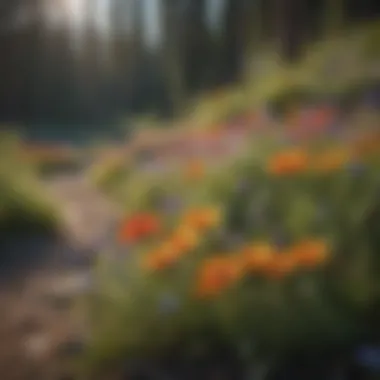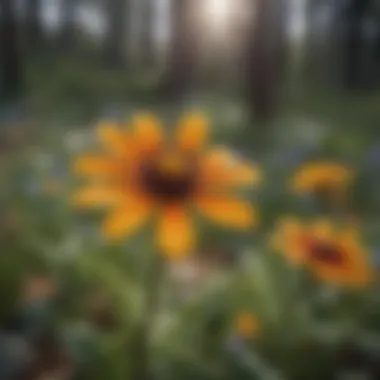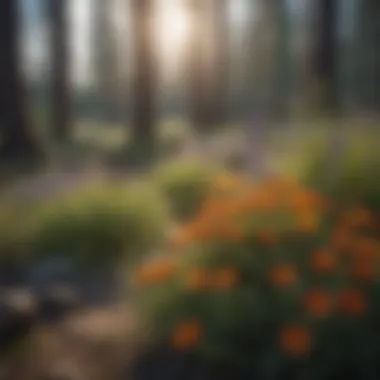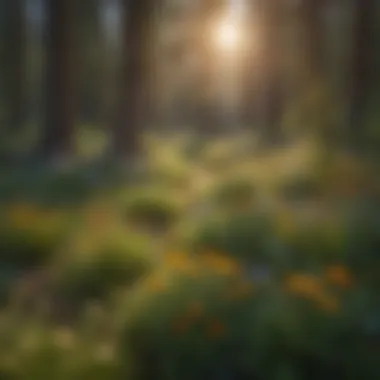Discovering Bend, Oregon's Native Wildflowers


Intro
Bend, Oregon is known for its breathtaking landscapes and diverse ecosystems. Among its natural gems are the multitude of wildflower species that bloom throughout the seasons. Understanding these flowers is essential, not only for their beauty but also for their ecological roles. Wildflowers contribute significantly to the local biodiversity and health of the environment. This article aims to guide forestry professionals and environmental advocates through the world of wildflowers in Bend, highlighting their native species, specific habitats, seasonal patterns, and conservation efforts.
Overview of Forestry Practices
Forestry refers to the science and craft of managing forests for various purposes, including conservation, timber production, and recreation. It plays a vital role in the stewardship of natural resources. Understanding forestry practices is key to preserving habitats where wildflowers thrive.
Definition of Forestry
Forestry encompasses a range of practices aimed at maintaining healthy forests. This includes planting trees, managing forested areas, and ensuring sustainable use of resources. Through proper management, forests can provide valuable services such as carbon sequestration, wildlife habitat, and erosion control.
Importance of Forestry in Ecosystem Management
Forestry is crucial in ecosystem management as it promotes biodiversity. Healthy forests support a variety of species, including many wildflowers. Without effective management, invasive species might disrupt native plant communities. By implementing forestry practices, we can maintain the ecological balance and ensure that wildflower populations remain stable.
Sustainable Forest Management
Sustainable forest management aims to fulfill current forest needs while ensuring future generations can also benefit from these ecosystems. It is centered on principles that protect the environment, economy, and community well-being.
Principles of Sustainable Practices
- Maintaining biodiversity: Encourage a variety of species to coexist, which enhances resilience.
- Restoration of habitats: Work on rehabilitating land that has been degraded.
- Efficient use of resources: Use forest products in ways that do not deplete resources.
Techniques in Sustainable Management
To implement sustainable practices, various techniques can be employed, such as:
- Selective logging that focuses on mature trees
- Creating buffer zones around wildflower habitats
- Monitoring species populations to assess health and viability
Woodland Stewardship Strategies
Woodland stewardship is the responsible management of forested areas. It involves landowners and managers taking proactive steps to maintain and enhance the quality of ecosystems.
Importance of Woodland Stewardship
Proper stewardship ensures that the unique flora and fauna, including wildflowers, are preserved for future generations. It fosters a deeper connection between people and the land, encouraging sustainable use of natural resources.
Best Practices for Landowners
Landowners can adopt several best practices, such as:
- Maintaining native plants that are already part of the ecosystem.
- Minimizing pesticide use to protect pollinators which are crucial for wildflower reproduction.
- Educating local communities about the importance of wildflowers and native plants.
Understanding the ecological significance of wildflowers is crucial for their preservation.
As we explore the diversity of wildflowers in Bend, Oregon, let us consider our role in their conservation and the overall health of the ecosystem.
Prologue to Wildflowers in Bend, Oregon
Wildflowers are an integral component of the ecosystems in Bend, Oregon. This region hosts a diverse range of native plant species, each contributing to the local biodiversity. Understanding these wildflowers not only enriches individuals' appreciation of the natural world but also underscores their ecological importance. For forestry professionals and environmental advocates, grasping the significance of these plants can inform conservation efforts and sustainable practices.
Geographical Context
Bend, situated in central Oregon, features a unique blend of geographic characteristics. The area is shaped by its mountainous terrain and high desert climate. The surrounding Cascade Mountains influence weather patterns, creating a variety of microclimates. This geographical diversity allows for a wide array of wildflower species to thrive. Various habitats, including meadows, forests, and rocky slopes, provide a suitable environment for numerous plants to grow.
As elevation increases, one can find different plant communities. For instance, lower elevations may have species such as bitterroot, while higher altitudes can support mountain heather. Understanding these geographical nuances is essential to appreciate the full spectrum of wildflowers found in Bend. Each ecosystem presents distinct challenges and benefits to plant life, reflecting the intricate balance between nature and location.


Significance of Wildflowers
Wildflowers play multiple crucial roles in the environment. First, they are vital for pollinator support. Many species rely on wildflowers for nectar and pollen, thus forming the foundation of a thriving ecosystem. The presence of diverse wildflower species contributes to healthier pollinator populations, which in turn supports the blooming of other plants in the area.
Moreover, wildflowers enhance soil health. The deep roots of many perennial wildflowers help stabilize soil and prevent erosion. This root structure also promotes the infiltration of water, maintaining soil moisture and minimizing runoff. Enhanced soil quality benefits not only wildflowers but also surrounding vegetation.
Lastly, wildflowers contribute to habitat formation. Their blooms attract various creatures, creating a dynamic ecosystem. This interdependence highlights the interconnectedness of all life forms. A decline in wildflower populations can lead to detrimental effects on entire wildlife communities.
Understanding and preserving wildflower populations is essential for maintaining biodiversity and healthy ecosystems in Bend and beyond.
Types of Wildflowers in Bend
Understanding the types of wildflowers in Bend, Oregon is essential to appreciating the region's rich biodiversity. This section delves into perennial, annual, and endemic wildflowers. Each type contributes uniquely to the ecosystem and showcases the variety of flora that thrives in the area. Recognizing these distinctions is important for conservation efforts and for those who admire these botanical wonders.
Perennial Wildflowers
Perennial wildflowers are a cornerstone of Bend's landscape. They are plants that live for more than two years, emerging each spring to bloom again. Some common examples include the Bitterroot and Prairie Starflower. These flowers adapt well to the local climate and soil conditions, establishing deep root systems that help them withstand dry periods. Moreover, their long lifespan allows them to play critical roles in habitat stabilization and soil enrichment.
The deep root systems of perennial wildflowers contribute significantly to soil health by reducing erosion and enhancing water retention.
Perennials are also vital in supporting local pollinators. Their consistent blooms provide food sources across multiple seasons. Thus, their preservation is crucial in maintaining ecological balance. Understanding their life cycles and growth patterns can guide conservation strategies.
Annual Wildflowers
Annual wildflowers complete their life cycle in a single growing season. They germinate, bloom, produce seeds, and die within a one-year timeframe. In Bend, flowers like California Poppy and Indian Blanket are prominent. These plants often exhibit a burst of colors in the spring and early summer. Their rapid growth and reproductive cycle make them particularly valuable in disturbed habitats.
Annuals add diversity to the floral landscape and provide important food sources for pollinating insects during their flowering periods. They can help regenerate soil fertility because they often bring nutrients back into the soil as they decompose.
Endemic Species
Endemic wildflowers are species unique to Bend or the surrounding region. This makes them invaluable in terms of conservation. Species like the Bend Mountain Buttercup and the Cascade Daisy are examples of such plants. Endemic species have evolved to suit specific local conditions, which means they may not survive well outside their natural habitats.
Their existence is a testament to the unique ecological characteristics of the area. Protecting these species is imperative, as losing them can negatively impact local biodiversity. Furthermore, endemic wildflowers often serve as indicators of environmental health. Conservation measures aimed at safeguarding these plants can also benefit the larger ecosystem.
Seasonal Patterns of Blooming
Understanding the seasonal patterns of blooming wildflowers in Bend, Oregon, is essential for both forestry professionals and environmental advocates. These patterns can indicate the health of local ecosystems and play a crucial role in biodiversity. Each season brings unique characteristics, which can inform conservation strategies and guide visitors in their observations. By grasping how seasonal changes affect wildflower growth, one can appreciate the dynamics of the local flora and the symbiotic relationships among species.
Spring Wildflower Bloom
Spring heralds a vibrant awakening in Bend's ecosystems, as wildflowers bloom in response to warming temperatures and increased daylight. Species such as the bitterroot and pussytoes are among the first to emerge, often coloring the landscape in delicate hues of pink and white.
The significance of spring blooms lies in their role as early food sources for pollinators. Bees, butterflies, and other insects are drawn to these flowers, establishing key interactions that support broader ecological networks. Additionally, observing the timing of these blooms provides insights into climate patterns and can inform ongoing conservation efforts. It is also crucial to note that early spring blooms may be sensitive to late frosts, presenting challenges for their survival and subsequent seed production.
Summer Wildflower Characteristics
As temperatures rise, summer brings forth a rich tapestry of wildflower species such as balsamroot, larkspur, and Indian paintbrush. This season is characterized by an explosion of color, with many flowers reaching their peak blooming period from June to August. The diverse range of blooms during this time supports a wide variety of pollinators, enhancing the sustainability of the ecosystem.
Summer wildflowers often exhibit adaptations to harsh conditions, such as drought resistance and deep root systems that allow them to access water during dry spells. These adaptations contribute to soil health, as their presence helps to prevent erosion and maintain nutrient balance. A thorough understanding of these characteristics can assist conservationists in developing strategies to protect and manage these ecosystems effectively.
Autumn Colors and Changes
As summer wanes, autumn transforms Bend's wildflower landscapes. Many species, including goldenrod and asters, begin their blooming cycle again, offering a final display of color before winter sets in. The autumn flowers often attract late-season pollinators, emphasizing their role in sustaining biodiversity.
During this season, wildflowers also play a vital role in preparing the ecosystem for winter. They contribute to seed dispersal, which is critical for maintaining plant populations in subsequent years. Additionally, as leaves change and fall, they contribute organic matter to the soil, enhancing its fertility.
In sum, recognizing seasonal patterns of blooming wildflowers is fundamental for understanding Bend's ecological framework. Not only do these flowers contribute to the aesthetic value of the area, but they also play indispensable roles in supporting wildlife populations and maintaining ecosystem balance. Through careful observation and study, we can enhance our approach to conservation efforts, ensuring the protection of these vital natural resources.
Ecological Roles of Wildflowers


Wildflowers play a crucial role in maintaining ecological balance in Bend, Oregon. They are not just aesthetically pleasing; they provide essential benefits that support the environment. Understanding the ecological functions of wildflowers can shed light on their significance in regional habitats. This section discusses how wildflowers contribute to pollinator support, enhance soil health, and form habitats that sustain various organisms.
Pollinator Support
Wildflowers serve as a vital resource for pollinators, including bees, butterflies, and other insects. These plants offer nectar and pollen, which are critical for the survival of many species. The diversity of wildflowers correlates with an increase in pollinator populations. Each flower species attracts specific pollinators, creating a symbiotic relationship essential for the reproduction of both wildflowers and their pollinators.
"A diverse array of wildflowers is crucial in supporting a healthy pollinator population, which is vital for food production and ecological balance."
When wildflowers bloom, they provide sustenance during various seasons. This variety ensures that pollinators have access to food throughout their life cycles. As such, preserving wildflower populations directly supports the stability of pollinator species.
Soil Health Contributions
Wildflowers contribute significantly to soil health. Their root systems promote soil structure and prevent erosion, which is essential in the hilly terrains of Bend. By stabilizing the soil, these plants reduce runoff and enhance water retention, allowing for a healthier ecosystem. Moreover, wildflowers improve soil fertility through a process known as nitrogen fixation, where certain species, like clover, enrich the soil with nitrogen.
Additionally, dying wildflowers decompose and add organic matter back into the soil. This cycling of nutrients is fundamental for sustaining other plant life in the area.
Habitat Formation
Wildflowers are fundamental in creating habitats for various organisms. Their growth facilitates the establishment of complex ecosystems that support smaller animals, insects, and even birds. Dense patches of wildflowers can provide shelter and nesting sites, essential for species survival. These patches often attract larger wildlife, forming a dynamic food web.
The presence of wildflowers can also indicate healthy ecosystems. Areas rich in diverse wildflower species are often more resilient and can better withstand environmental changes.
Overall, the ecological roles of wildflowers are essential for sustaining the environment in Bend, Oregon. Their intricate relationships with pollinators, contributions to soil health, and formation of habitats are key to maintaining biodiversity and ecological health in the region. Understanding these roles lays the groundwork for further discussions on threats to these populations and the importance of conservation.
Threats to Wildflower Populations
Wildflowers in Bend, Oregon face a multitude of threats. Understanding these threats is crucial for the conservation and longevity of these important species. Each element discussed below presents unique challenges that can significantly impact wildflower populations. Addressing these issues is essential not only for the flowers themselves but also for the overall ecosystem they support.
Land Development
Land development poses a critical danger to wildflower populations. As urban areas expand, natural habitats are destroyed or altered. This often leads to the fragmentation of ecosystems. When wildflower habitats are compromised, it reduces their ability to reproduce and flourish. The introduction of infrastructure can also lead to soil compaction, altering drainage patterns and affecting local flora.
"The loss of habitat due to land development is one of the major contributors to the decline of wildflower species in Bend."
Moreover, the increase in human activity leads to higher levels of pollution and disturbances. These factors can prevent wildflowers from establishing themselves. Zoning laws and land use regulations often favor development over conservation. This underscores the need for strategies that prioritize preserving natural habitats while accommodating growth.
Invasive Species
Invasive species are another significant threat to wildflowers in Oregon. These non-native plants can disrupt local ecosystems. They often outcompete native species, including wildflowers, for important resources such as light, water, and nutrients. When invasive species become established, they can create monocultures that diminish biodiversity.
Common invasive plants in the region can alter habitats and ecological balances. This shift can inhibit the growth of native wildflowers, limiting their presence in the ecosystem. Prevention and management of invasive species are vital to protecting Bend's native flora. Programs focused on removal and control can help restore the balance needed for wildflowers to thrive.
Climate Change Impacts
Climate change is already having noticeable effects on wildflower populations. Changes in temperature and precipitation patterns can disrupt blooming cycles and lead to mismatches in pollination. Some wildflowers may not adapt quickly enough to the rapid changes, potentially leading to declines in their populations.
Additionally, shifting climate zones can result in the loss of suitable habitats. As temperatures rise, areas that once supported diverse wildflower populations may become inhospitable. This situation threatens not just the wildflowers but also the insects and animals that depend on them. The impact of climate change highlights the importance of ongoing research and adaptive management strategies to protect Bend's wildflower diversity.
Addressing these threats will take a concerted effort from local conservation groups, government agencies, and the community. Keeping wildflower populations sustainable is crucial for maintaining the biodiversity and beauty of Bend's ecosystems.
Conservation and Restoration Efforts
The wildflower landscapes in Bend, Oregon hold ecological value that transcends simple beauty. Conservation and restoration efforts aimed at protecting these flora are critical for maintaining biodiversity and ecosystem health. This section explores the various dimensions of such efforts and their significance.
Local Conservation Groups
Local conservation groups play a pivotal role in the preservation of wildflower habitats. Organizations like the Central Oregon LandWatch focus on protecting the integrity of local ecosystems through advocacy and education. These groups work tirelessly to promote sustainable practices and prevent overdevelopment that threatens native plant species.
Engaging the community is a crucial part of these organizations' missions. Many of them organize volunteer events to remove invasive species that compete with native wildflowers. By raising awareness about the importance of these plants, they foster a sense of stewardship among residents.


Restoration Projects
Restoration projects are essential for rehabilitating ecosystems affected by human activities or natural disasters. Numerous initiatives in Bend focus on restoring degraded habitats to create favorable conditions for wildflowers to thrive. These projects often involve planting native species, which enhances overall biodiversity and helps stabilize soils.
Some specific efforts include reintroducing wildflower species that have become scarce due to urbanization. The process typically requires thorough site assessments and a strategic approach to ensure viable growth in new environments. These restoration activities provide not only ecological benefits but also serve as a platform for education on the importance of native flora.
Community Involvement
Community involvement is vital for successful conservation and restoration efforts. Local citizens can contribute in many ways, from supporting conservation groups to participating in planting events. Programs aimed at educating the public about the ecological and aesthetic value of wildflowers encourage long-term commitment to their preservation.
Furthermore, involving the community strengthens connections between people and nature. People learn to appreciate what they see in their surroundings, fostering a culture of care and conservation. Opportunities for workshops or guided nature walks can bolster these efforts by providing residents with knowledge on identifying local wildflowers and their role in the ecosystem.
"Wildflowers are not just plants; they are keystones of ecological balance. Conservation efforts hinge upon understanding their importance in local biodiversity."
The collaboration between local organizations, restoration initiatives, and community participation creates a robust framework for the sustainability of wildflower populations in Bend. Engaging in these efforts not only preserves the environment but also enhances the quality of life for residents who share in the natural beauty of their surroundings.
Best Practices for Observation
Observing wildflowers requires more than just enthusiasm. Best practices ensure that the experience is enjoyable for both the observer and the ecosystem. Learning to appreciate these plants in their natural environment enhances enjoyment and fosters a culture of respect towards nature's delicate balance. Proper observation can help protect wildflower populations and supports ongoing conservation efforts. The following aspects are essential for an enriching experience.
Timing for Wildflower Viewing
The timing of your visit significantly influences your wildflower observation experience. Each species has a unique blooming period, and understanding these cycles is crucial. In Bend, wildflowers generally bloom from late spring through early autumn. Spring is particularly vibrant with wildflowers like the Oregon grape, which typically blossoms in March. The peak for many species usually falls between April and June.
Try to plan your visits during the early morning or late afternoon. The light during these times enhances color contrasts, adding depth to your observations. Furthermore, the cooler temperatures attract more active pollinators, enriching the ecosystem you are studying. Keeping a record of your observations can also help in synchronizing future visits with blooming patterns.
Respectful Observation Tips
Practicing respect towards wildflowers is crucial for their survival and for maintaining the integrity of their habitat. Here are some key tips for observing wildflowers responsibly:
- Stay on designated paths: This minimizes habitat disturbance and prevents trampling of delicate plants.
- Avoid picking flowers: Collecting wildflowers can lead to population decline and disrupt local ecosystems. Photograph them instead.
- Observe quietly: Sudden movements or loud noises can scare away pollinators and other wildlife. Approach observation sites calmly.
- Educate others: Share your knowledge about the importance of wildflowers and their preservation with those around you.
- Use adequate gear: When photographing, opt for equipment that keeps you distant enough not to disturb the surroundings. A long lens is beneficial.
By following these best practices, we can enjoy the beauty of wildflowers in Bend, Oregon, while contributing to their preservation.
Practicing good observation not only enriches personal experiences but also enhances the broader efforts of conservation. A keen observer can make a positive impact, ensuring wildflower populations can flourish for future generations.
Photography Insights
Photography of wildflowers offers numerous benefits, particularly for those engaged in forestry and environmental studies. Capturing these flowers not only preserves their beauty but also documents their ecological significance. High-quality images can serve educational purposes, helping others understand the role of these plants in their habitats. Additionally, photographs can induce a greater appreciation among the public for local flora, potentially inspiring conservation efforts. This section will delve into the techniques needed for effectively capturing wildflowers, as well as the ethical considerations when photographing nature.
Techniques for Capturing Wildflowers
To achieve stunning photographs of wildflowers, one should consider several factors:
- Lighting: Natural light plays a crucial role. Early mornings or late afternoons offer the best lighting. The soft light during these times enhances the colors and details of the flowers.
- Composition: Use the rule of thirds to create more balanced images. Placing the flower off-center can make for a more interesting shot.
- Focus: It is vital to have a clear focal point. Using a shallow depth of field helps to isolate the flower from its background, making it stand out.
- Angles and Perspectives: Experiment with different angles. Getting low to the ground or shooting from above can provide unique perspectives, enriching the image’s appeal.
- Tripod Use: For macro photography, stabilizing the camera with a tripod can help in achieving sharper images, especially in low light conditions.
Respecting Nature While Shooting
While photography can bring awareness to wildflowers, it is essential to respect the natural environment. Here are key considerations to keep in mind:
- Stay on Trails: To protect the surrounding habitat, always shoot from established paths. This practice minimizes disturbance to the native plants.
- Avoid Picking Flowers: It is important to let flowers flourish in their natural settings. Picking them for photography can lead to a decline in local populations.
- Be Mindful of Wildlife: Wildlife often relies on wildflowers for sustenance. Avoid disrupting animals during your shoots.
- Leave No Trace: Carry out what you bring in. Ensure that all trash is disposed of properly. This helps maintain a clean habitat for all.
"Respect for nature is fundamental in any outdoor activity, including photography. Understanding the balance of life plays an important role in conservation."
Ending
In this article, we have explored the realm of wildflowers native to Bend, Oregon. Understanding the importance of wildflowers extends beyond aesthetic appreciation; it encapsulates ecological, environmental, and social considerations.
Reflection on Wildflower Significance
Wildflowers play a critical role in maintaining biodiversity. They support various pollinators such as bees and butterflies, which are essential for the pollination of many plants. This interdependence facilitates the growth of diverse plant communities and promotes overall ecosystem health. Moreover, wildflowers contribute to soil stabilization and nutrient cycling, which are vital for sustaining the habitats they occupy. Recognizing these ecological significances enhances our appreciation for wildflowers and underscores the need for their conservation.
Future Directions for Wildflower Conservation
Looking forward, there are several key initiatives necessary for the conservation of wildflowers in Bend. First, public awareness campaigns can educate the community about the importance of native plant preservation. Collaboration with local conservation groups and governmental agencies will also be essential. Restoring habitats degraded by invasive species or development can help re-establish native wildflower populations. Lastly, ongoing research into the effects of climate change on wildflower distributions is crucial. Addressing these concerns will promote healthy ecosystems and preserve the natural beauty of Bend's wildflowers for future generations.







